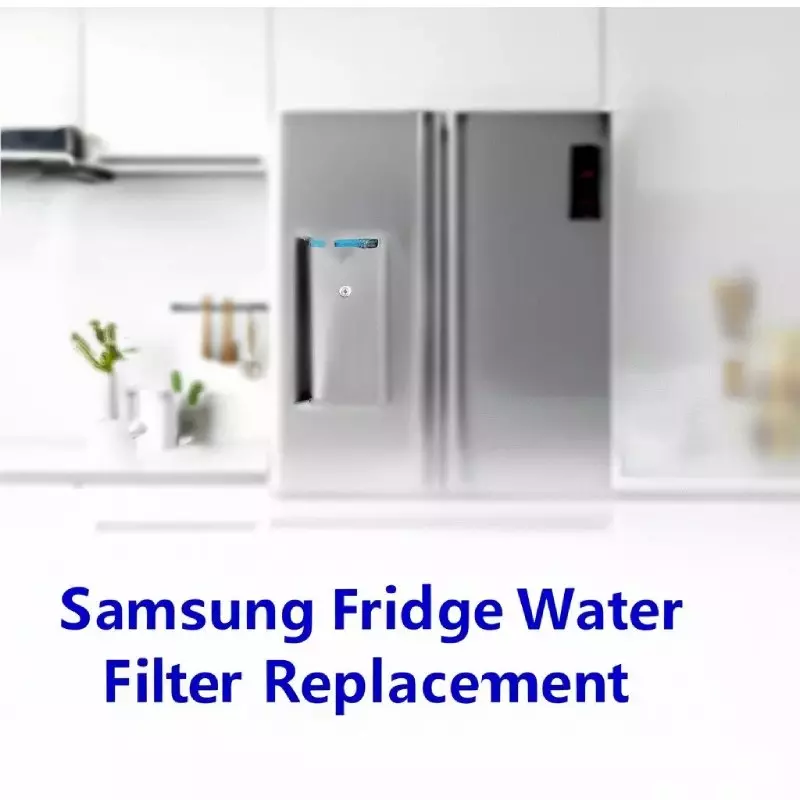A properly functioning water filter keeps your Samsung refrigerator’s water and ice tasting fresh and clean. Over time, these filters capture impurities, and replacing them regularly is crucial for maintaining optimal water quality and the performance of your dispenser and ice maker.

This general guide provides essential information for replacing the water filter in your Samsung refrigerator. Please refer to the dedicated guides below for detailed, step-by-step instructions for your refrigerator type.
Why Replace Your Water Filter?
- Improved Taste and Odor: Removes chlorine, sediment, and other substances that can affect the taste and smell of your water and ice.
- Healthier Water: Reduces specific contaminants (check your filter’s specifications for details).
- Appliance Longevity: Prevents mineral buildup that can damage your refrigerator’s internal components, dispenser, and ice maker.
- Optimal Performance: Ensures good water flow to your dispenser and efficient ice production.
When to Replace Your Water Filter:
- Filter Indicator Light: Most Samsung refrigerators have a filter indicator light on the control panel or dispenser. When this light illuminates (often turning red or orange), it’s time for a replacement.
- Every 6 Months (General Rule): Even if the indicator light hasn’t come on, replacing your water filter every six months is generally recommended, depending on your water quality and usage.
- Noticeable Decrease in Water Flow: If you observe a significant reduction in water flow from the dispenser, the filter may be clogged.
- Changes in Taste or Odor: If your water or ice starts to taste or smell off, it’s a good sign the filter needs changing.
Before You Begin Any Replacement:
- Identify Your Refrigerator Type: Knowing your refrigerator’s style is key to finding the correct detailed instructions. Common Samsung types include:
- Side-by-Side
- French Door
- 4-Door Flex™ / Multi-Door Flex™
- Purchase the Correct Replacement Filter:
- Crucial: Always use a genuine Samsung water filter or a manufacturer-certified compatible filter specifically designed for your refrigerator model. Using an incorrect or unapproved filter can lead to leaks, damage to your refrigerator, or poor filtration.
- Finding the Part Number: You can usually find the filter model number printed on your old filter, in your refrigerator’s user manual, or by searching online using your full model number.
- Gather Supplies: A towel is handy for catching minor water drips during replacement.
- Consider Shutting Off the Water Supply (Recommended): While not always mandatory for all internal filter changes, shutting off the water supply valve to your refrigerator (typically located behind the fridge, under it, or the sink) is a reasonable precaution to prevent any unexpected water flow.
General Filter Replacement Overview (Detailed Steps Vary by Type):
The basic process usually involves:
- Locating the filter is the most variable step, depending on your fridge type.
- Removing the old filter: This often involves a twisting motion or pressing a release button.
- Inserting the new filter: Ensuring it’s properly aligned and securely locked.
Detailed Water Filter Replacement Instructions by Refrigerator Type:
Please click on the links below that correspond to your Samsung refrigerator type for specific, step-by-step replacement instructions. We have provided two resource links for each type to offer comprehensive guidance:
- Samsung Side-by-Side Refrigerator Water Filter Replacement:
- Samsung French Door Refrigerator Water Filter Replacement:
- Samsung 4-Door Flex™ / Multi-Door Flex™ Refrigerator Water Filter Replacement:
After Replacing the Filter (General Steps):
Once you’ve followed the specific instructions for your refrigerator type and installed the new filter:
- Turn the Water Supply Back On (if you shut it off).
- Flush the New Filter: This is a critical step. Dispense water through the dispenser for approximately 5-7 minutes (as your filter manufacturer recommends).
- Purpose: This clears out any trapped air from the water lines and flushes out any loose carbon particles from the new filter.
- What to Expect: The water may initially appear cloudy or spurt from the dispenser. This is normal and will clear up.
- Reset the Filter Indicator Light: After replacing the filter, you’ll need to reset the indicator light on your refrigerator’s control panel or display so it can accurately track the life of the new filter.
- Non-Family Hub Models: This typically involves pressing and holding a specific button or combination of buttons (e.g., “Ice Type,” “Water,” “Filter Reset,” “Crushed Ice,” etc.) on the dispenser control panel for 3-5 seconds until the indicator light changes color or turns off. Refer to your refrigerator’s user manual for the exact button(s) and procedure for your model.
- Family Hub™ Models: If your Samsung refrigerator is equipped with a Family Hub™ screen, the reset process is usually done through the digital interface. Navigate to: Fridge Manager > Fridge Settings > Water Filter and tap Reset.
Troubleshooting Common Issues:
- Water Leaks After Installation:
- Ensure the filter is fully inserted and locked into place.
- Check that you are using the correct filter model for your refrigerator.
- Inspect the filter housing for any cracks or damage.
- Filter Indicator Won’t Reset:
- Double-check your user manual for the precise reset procedure for your specific model.
- Ensure you press the correct button(s) for the required time.
- Slow Water Flow After Replacement:
- Make sure the filter is installed correctly.
- If the problem persists, there might be an issue with your home’s water pressure or the refrigerator’s water line.
Conclusion:
Regularly replacing your Samsung refrigerator’s water filter is a simple yet essential maintenance task that significantly contributes to the quality of your water and ice and the longevity of your appliance. You can easily perform this task by following the general guidelines and the specific instructions for your refrigerator type.
Refer to your Samsung refrigerator’s user manual for the most accurate and detailed instructions about your specific model.
